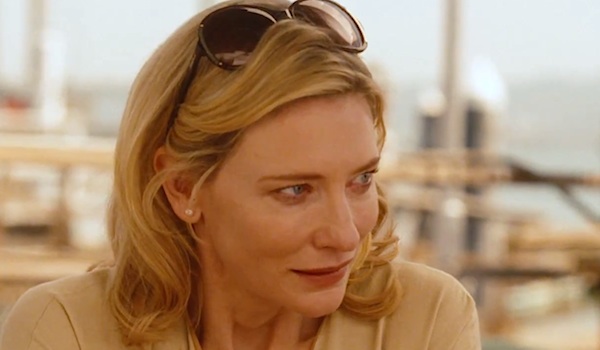Blue Jasmine Review
Posted on September 8, 2013 By John Gilpatrick 2013, Movie Reviews, New Releases
In 1988, Pedro Almodóvar directed Women on the Verge of a Nervous Breakdown. In 2013, Woody Allen directed Blue Jasmine, a.k.a. “Woman on the Verge of Another Nervous Breakdown (or: How I Learned to Stop Worrying and Love Stoli Martinis with a Twist of Lemon)”.
Blue Jasmine is a far cry from the nostalgic delights of Midnight in Paris and the misguided slapstick of To Rome with Love. It’s a mixed bag of a serious Woody Allen movie insofar as it tells a coherent, compelling narrative that never quite clicked for me tonally. But Cate Blanchett, my God, Cate Blanchett! Hers is not just the finest performance of 2013 so far, but one of the very best performances Woody Allen has ever coaxed out of an actor, male or female. It’s astoundingly assured work that’s completely convincing and rather frightening, as well. She’s the reason to see this movie. Hell, she is this movie.
Blanchett plays Jasmine, a woman who once had it all before her millionaire husband (Alec Baldwin) was arrested and imprisoned for financial crimes. Jasmine had a nervous breakdown (she was found talking to herself on the streets of New York), so she’s moving to San Francisco to live with her sister, Ginger (Sally Hawkins), until she can get back on her feet.
Jasmine (formerly Jeanette) and Ginger aren’t particularly close. Both women were adopted, and Ginger always carried a chip on her shoulder, claiming their mother thought her genes were inferior to Jasmine’s. Their vast differences in financial status exacerbated their problems, but Ginger’s tendency to date down, i.e. fall in love with “losers,” makes their living together quite contentious at times. But each woman has her goals: Jasmine to learn about computers so she can study interior design online; Ginger to help her sister out so she can leave sooner and so her boyfriend, Chili (Bobby Cannavale), can move in. And each woman, as unfiltered as she might be at times, is quite determined to make their less-than-ideal situation work.
Let’s start with the good, and the good starts (and nearly ends) with Blanchett. Her Jasmine is a horrifying individual on a number of levels. Her attitude toward those less fortunate than her (and more importantly, those she thinks are less fortunate than her) is downright appalling. But this is a sick, sick woman—driven legitimately crazy by suddenly having to confront the terrible things her husband did—things she’s somewhat knowingly looked away from for years. It’s an unenviable situation, and makes this otherwise unsympathetic woman quite pitiable. That’s arguably Blanchett’s and Allen’s greatest accomplishment here.
Otherwise, the film is a bit of a mixed bag. It’s one of Allen’s more streamlined pictures in recent memory, that is to say there are few zany tangents. Everything in the film relates to Jasmine’s or Ginger’s life in some important way. Tonally, however, Blue Jasmine was a little uncomfortable for my taste. It’s dealing with very serious subject matter, but I’d argue it does so in a way that’s not exactly serious enough, which makes the film come across as judgmental.
I keep coming back to Blanchett, however, and her firecracker performance. It lords over the fine work of Sally Hawkins, Andrew Dice Clay, Bobby Cannavale, and Louis CK. It renders Javier Aguirresarobe’s solid, sun-kissed San Francisco cinematography rather forgettable. It makes this Woody Allen movie feel a lot less like a Woody Allen movie, if I’m being honest, and maybe that’s part of the reason I didn’t respond to the film as a whole too strongly. That said, the film is absolutely recommendable (if not unreservedly) because Cate Blanchett, my God, Cate Blanchett.
2013, 3 Stars, Alden Ehrenreich, Alec Baldwin, Alisa Lepselter, Andrew Dice Clay, Blue Jasmine, Bobby Cannavale, Cate Blanchett, Javier Aguirresarobe, Louis C.K., Michael Stuhlbarg, Peter Sarsgaard, Sally Hawkins, Woody Allen

















Pingback: Reviews: Blue Jasmine (2013) | Online Film Critics Society